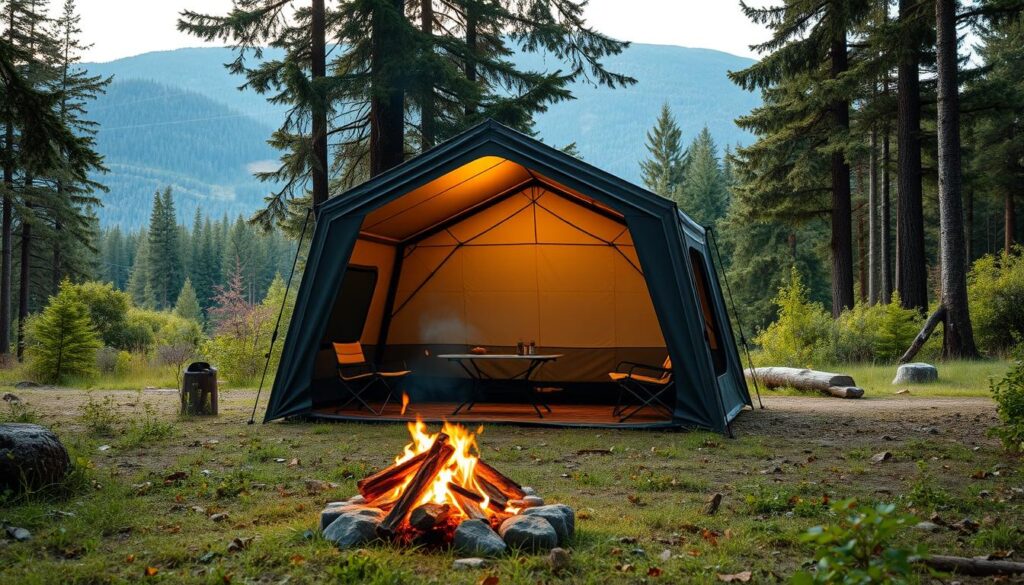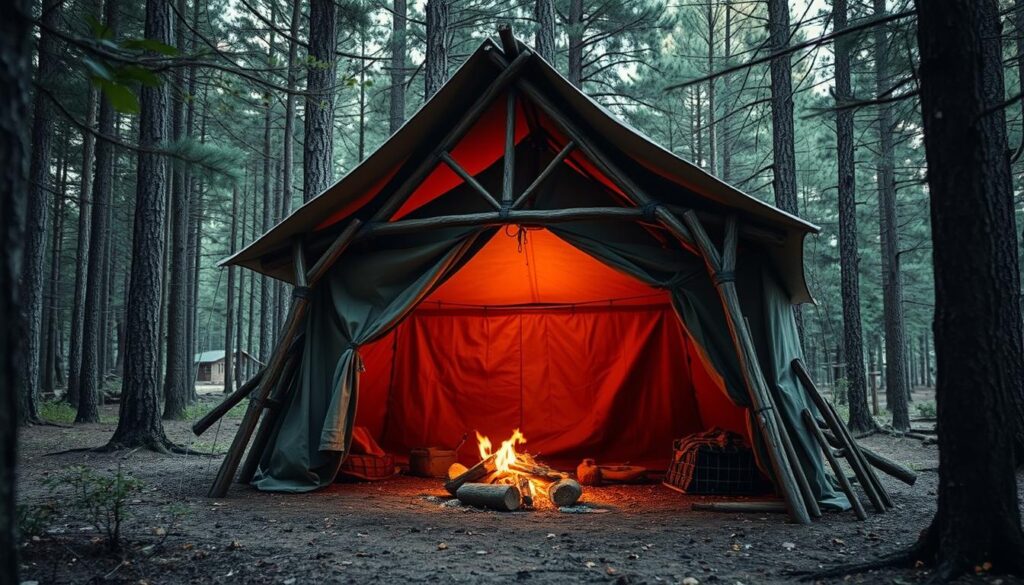Thinking back on my outdoor adventures, I see how key a good shelter is. It keeps me comfortable and safe from the weather.
When camping, hiking, or dealing with an emergency, a solid portable shelter is essential. It can really save the day.
In this guide, I’ll show you how to set up a reliable shelter that fits your needs.
Key Takeaways
- Understand the importance of a portable shelter in outdoor activities.
- Learn how to choose the best portable shelter for your needs.
- Discover the essential steps to setting up your shelter.
- Gain insights into common mistakes to avoid when setting up a shelter.
- Understand how to maintain and care for your portable shelter.
What is a Portable Shelter?
A portable shelter is more than just a temporary place to stay. It’s a flexible solution for many situations. Whether you’re going on an outdoor adventure, preparing for emergencies, or need a temporary workspace, knowing about portable shelters is key.
Definition and Purpose
A portable shelter is made to be easy to move and set up. It protects you from the weather. It can be a temporary home for camping or a safe place in emergencies.
Portable shelters are known for being lightweight, strong, and simple to put together. These qualities make them great for people and groups looking for quick and effective shelter options.
Types of Portable Shelters
There are many types of portable shelters, each for different needs and places. Here are some common ones:
- Emergency Bivvy: A small, light shelter for emergencies.
- Tarp Shelter: A flexible, simple shelter from waterproof tarps.
- Tube Tent: A light, easy tent for quick shelter.
- Bothy Bag: A waterproof bag for emergency shelter.
These shelters are good for camping and recreation, emergencies, and temporary workspaces. The right shelter depends on your needs, like the environment, how long you’ll use it, and what you like.
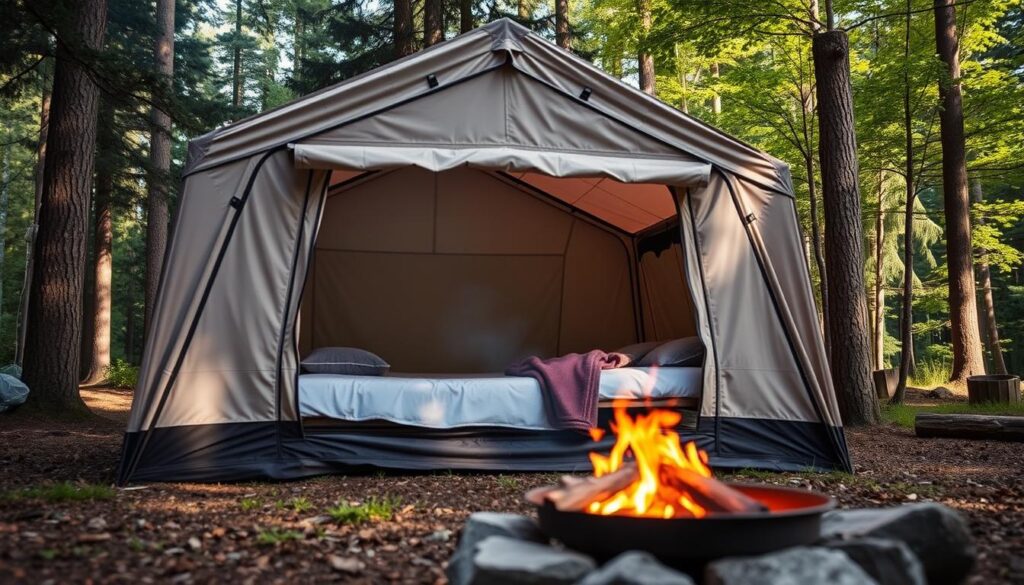
Benefits of Using Portable Shelters
Portable shelters offer many benefits, like being easy to use and cost-effective. They are vital for outdoor adventures and emergency situations.
Versatility for Various Situations
Portable shelters are versatile, meeting different needs. They’re great for camping, temporary workspaces, or emergency shelters.
- Outdoor lovers can use them for camping or as a base during hikes.
- In emergencies, they provide quick housing or a command center.
- They’re also perfect for events or temporary workspaces.
Easy Transportation and Setup
Portable shelters are easy to move and set up. They’re lightweight and compact, making them simple to transport.
Key features for easy transport and setup include:
- Lightweight materials that make them easy to carry.
- Compact designs for easy transport.
- Simple setup mechanisms for quick assembly.
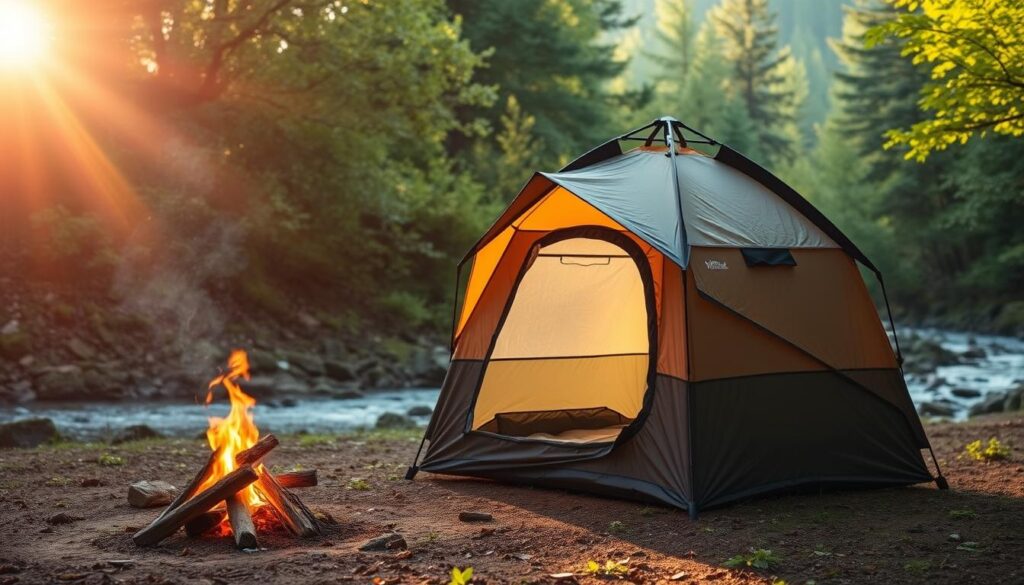
Cost-Effectiveness Compared to Traditional Structures
Portable shelters are cheaper than traditional structures. They save on initial costs and long-term maintenance.
Choosing a portable shelter can lead to big savings. They’re a smart choice for both temporary and semi-permanent needs.
Choosing the Right Portable Shelter for Your Needs
Choosing a portable shelter requires careful thought. It’s important for camping, emergencies, or temporary workspaces. The right shelter can greatly impact your experience.
Factors to Consider
Several factors are important when picking a portable shelter. These include weight, protection, capacity, set-up, and durability. For example, a light shelter is easy to carry but might not last as long as a heavier one.
For camping, look for a shelter that’s easy to set up and keeps out the weather. In emergencies, durability and weather protection are key. For more tips, check out this article on choosing the right shelter.
Comparing Materials and Durability
The material and durability of a portable shelter are very important. They affect how well it works and lasts. Common materials are nylon, polyester, and canvas, each with its own benefits and drawbacks.
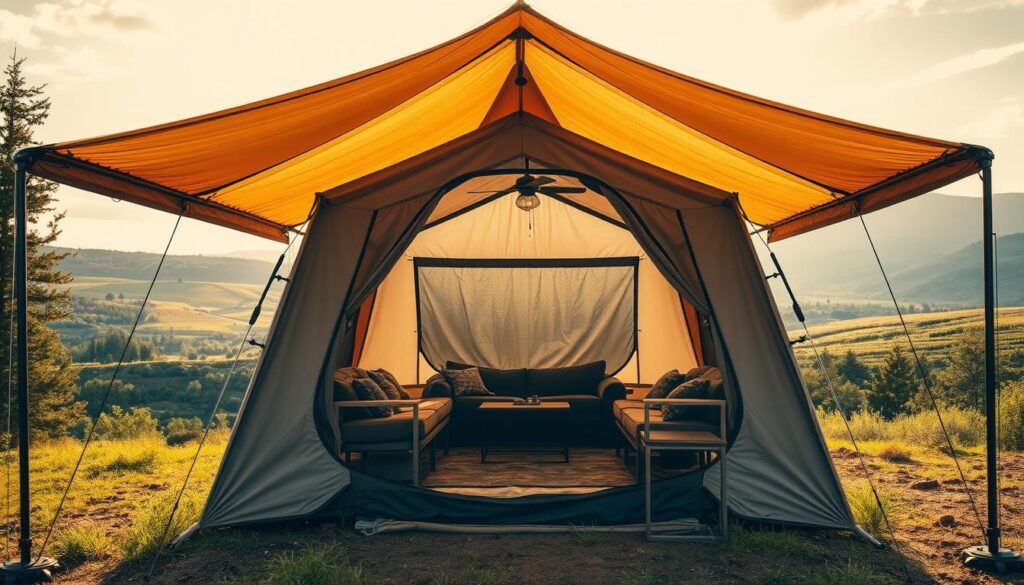
Nylon is light and water-resistant, great for backpacking tents. Polyester is durable and resists UV rays, perfect for long-term outdoor use. Canvas is durable but heavier and needs more care.
When comparing materials, think about the shelter’s frame and how it’s anchored. A strong frame keeps it stable, and good anchoring keeps it in place. For a durable portable shelter, choose high-quality materials and construction.
The best portable shelter for you depends on your needs and what you like. By looking at material, durability, and setup, you can find an affordable portable shelter that fits your needs and budget.
Essential Components of a Portable Shelter
A portable shelter needs several key parts to work well. These parts help keep you safe and comfortable. The main parts are the framework, covers, and how it’s anchored.
Framework and Structure
The framework is the heart of a lightweight shelter. It gives the shelter its shape and support. It’s made from strong, light materials like aluminum or fiberglass.
Covers and Enclosures
Covers and enclosures keep you dry and protected. They’re made from materials that won’t let water in, like nylon or polyester. The quality of these covers is key to the shelter’s life and how well it works.
For more tips on setting up shelters, check out crafting an emergency shelter. It has a detailed guide on how to set one up.
Anchoring Systems
Anchoring systems keep the shelter in place. They stop it from moving in the wind or other forces. You can use stakes, ropes, or weights for anchoring.
The right anchoring depends on where you are and the shelter type. For example, stakes work well in sandy ground, but weights might be better in rocky areas.
In short, knowing what makes a portable shelter good is important. With a strong framework, good covers, and solid anchoring, your portable shelter will keep you safe and comfy in many situations.
Step-by-Step Setup Instructions
Setting up a portable shelter is easy with the right guide. It’s great for camping or as an easy to set up shelter in emergencies. A step-by-step approach makes it safe and sturdy.
Selecting the Perfect Location
First, pick a good spot for your portable shelter for camping or other uses. Look for a place that’s level, dry, and safe from bad weather like strong winds or too much sun.
- Make sure the ground is solid and won’t flood.
- Stay away from places with branches or other dangers.
- If you’re with friends, think about how close you’ll be to others and facilities.
Preparing the Ground
After picking your spot, get the ground ready for your shelter. Remove any trash, rocks, or sticks that could mess up the setup or hurt the shelter.
Assembly Process
The way you put together your portable shelter for camping depends on the model. But most have an easy guide. Start by taking everything out and arranging it.
- Follow the maker’s guide to build the frame, making sure it’s strong.
- Put on the cover or enclosure, making sure it fits well on the frame.
- Use the anchors to keep the shelter steady against wind and other weather.
By following these steps, you can quickly set up an easy to set up shelter. It’s perfect for camping, emergencies, or temporary workspaces.
Maintenance Tips for Portable Shelters
Keeping your portable shelter for outdoor activities in good shape is key. A well-kept shelter keeps you safe and makes your outdoor time better.
To keep a durable portable shelter in top condition, follow some important steps. First, learn about your shelter’s parts and how they help it work well.
Regular Inspections
Checking your shelter often is a must. Do this after each use and before you put it away.
- Look for any wear and tear on the fabric, poles, and parts.
- Make sure zippers, buckles, and other fasteners work right.
- Check for damage from weather, like UV damage or water harm.
A top maker says, “Regular checks can really help your portable shelter last longer and save you money on repairs.”
“The life of a portable shelter depends a lot on how well you take care of it. Regular checks and quick fixes are key.”
Cleaning and Weatherproofing
It’s important to clean your portable shelter often. This keeps it weatherproof and in good shape.
- Use a mild soap and water to clean the fabric and parts.
- Put a waterproofing treatment on the fabric to keep it water-resistant.
- Make sure everything is dry before you store the shelter to avoid mold and mildew.
| Maintenance Task | Frequency | Benefits |
|---|---|---|
| Inspect for wear and tear | After each use | Prevents damage, ensures safety |
| Clean the shelter | Every 2-3 uses | Maintains weather resistance, hygiene |
| Apply waterproofing treatment | Every 6 months | Enhances water resistance, durability |
By sticking to these maintenance tips, your durable portable shelter will stay in great shape. This means you’ll have a safe and comfy outdoor experience for many years.
Best Practices for Storing Your Portable Shelter
Storing your affordable portable shelter right is key to keeping it in top shape. It helps your shelter last longer and be ready for use anytime.
To store your best portable shelter well, focus on folding and safe storage. Folding right saves space and keeps the shelter from getting damaged.
Folding Techniques
Folding your portable shelter correctly is the first step in safe storage. Always follow the instructions from the maker.
- Clean the shelter before folding to prevent dirt from causing damage.
- Ensure the shelter is dry to prevent mold and mildew.
- Fold the shelter according to the manufacturer’s instructions to avoid damaging the frame or fabric.
Storing Materials Safely
After folding your shelter, it’s key to store it safely. Here’s how:
- Store the shelter in a dry, cool place, away from direct sunlight.
- Keep it away from chemicals or materials that could cause damage.
- Use a storage bag or container to protect it from dust and pests.
Checking your stored shelter often helps spot problems early. This keeps it in great shape.
| Storage Aspect | Best Practice | Benefit |
|---|---|---|
| Folding | Follow manufacturer’s instructions | Prevents damage to frame and fabric |
| Storage Location | Dry, cool place away from sunlight | Reduces risk of mold and degradation |
| Protection | Use storage bag or container | Protects from dust and pests |
By following these tips, your best portable shelter will stay in great shape. It’ll be ready for your next adventure or emergency.
Real-Life Applications of Portable Shelters
Portable shelters are super useful in many situations, like camping and helping out in emergencies. They meet different needs, from fun outdoor activities to temporary work areas.
Camping and Recreation
For those who love the outdoors, lightweight shelters are a big help. They keep you dry and comfortable, and are simple to put up and carry. They make camping in the mountains or beach trips better.
Campers love how easy these shelters are to set up and take down. This makes it simple to go on spontaneous adventures without the trouble of setting up a big tent.
Emergency Situations
In emergencies, like big storms or earthquakes, portable shelters offer quick help. They can be homes for people who lost theirs. Their quick setup and strong build are key in these tough times.
First responders use these shelters for bases, medical spots, or places to stay. Their flexibility and simplicity are very important when time is of the essence.
Temporary Workspaces
Portable shelters also work well as temporary workspaces. On construction sites, they serve as offices or places to store things. They can move around easily, fitting well into changing work settings.
They’re also great for events, like festivals or concerts. They give vendors and staff the things they need. Their ability to fit into many situations makes them very useful.
| Application | Benefits | Examples |
|---|---|---|
| Camping and Recreation | Easy to set up, lightweight, protection from elements | Camping trips, beach outings, outdoor festivals |
| Emergency Situations | Quick setup, durable, versatile | Natural disaster relief, emergency response, temporary housing |
| Temporary Workspaces | Practical, adaptable, easily relocated | Construction site offices, event vendor spaces, storage facilities |
Conclusion: Embracing the Flexibility of Portable Shelters
Portable shelters are versatile and practical for many needs. They’re great for outdoor lovers or those needing a temporary workspace. A portable shelter can be very useful.
Setting up a portable shelter is easy. It doesn’t take much effort or equipment. With the right shelter, you can enjoy the outdoors while staying safe from the weather.
When choosing a portable shelter, think about durability, material, and how it’s anchored. These shelters are useful for camping, recreation, emergencies, and temporary workspaces.
Portable shelters offer a reliable and efficient solution. They’re easy to move and set up wherever you need them. Embracing their flexibility can be very beneficial.
FAQ
What is the best portable shelter for camping?
The best portable shelter for camping varies. It depends on how many people it needs to hold, the weather, and what you like. The REI Co-op Base Camp 6 and the MSR Elixir 4 are good choices.
How do I choose a lightweight shelter for outdoor activities?
Look at the material, size, and how easy it is to set up when picking a lightweight shelter. Choose durable, waterproof materials like nylon or polyester. Also, consider the weight and how small it packs up.
What are the essential components of a durable portable shelter?
A good portable shelter has a strong frame, waterproof covers, and solid anchoring systems. The frame keeps it standing, the covers keep you dry, and the anchors keep it in place.
How do I set up a portable shelter quickly and easily?
Follow the instructions from the maker. Pick a flat, dry spot. Get the ground ready before you start. Use anchors to keep it stable.
How do I maintain my portable shelter to ensure its longevity?
Check it often, clean it, and keep it weatherproof. Look for damage, clean it well, and use waterproofing when needed. This keeps it lasting longer.
What are the benefits of using a portable shelter for emergency situations?
Portable shelters are great for emergencies. They keep you dry and safe. They’re also easy to carry and set up, perfect for disaster relief.
Can I use a portable shelter as a temporary workspace?
Yes, you can use a portable shelter as a temporary office. It’s dry and comfy. They’re good for construction sites, outdoor events, and more.
How do I store my portable shelter when not in use?
Store it as the maker says. Keep it in a dry, cool spot. Clean and dry it first to avoid damage and mildew.
What is the average cost of a portable shelter?
Prices vary a lot. Basic ones start at 0. More advanced ones can cost over
FAQ
What is the best portable shelter for camping?
The best portable shelter for camping varies. It depends on how many people it needs to hold, the weather, and what you like. The REI Co-op Base Camp 6 and the MSR Elixir 4 are good choices.
How do I choose a lightweight shelter for outdoor activities?
Look at the material, size, and how easy it is to set up when picking a lightweight shelter. Choose durable, waterproof materials like nylon or polyester. Also, consider the weight and how small it packs up.
What are the essential components of a durable portable shelter?
A good portable shelter has a strong frame, waterproof covers, and solid anchoring systems. The frame keeps it standing, the covers keep you dry, and the anchors keep it in place.
How do I set up a portable shelter quickly and easily?
Follow the instructions from the maker. Pick a flat, dry spot. Get the ground ready before you start. Use anchors to keep it stable.
How do I maintain my portable shelter to ensure its longevity?
Check it often, clean it, and keep it weatherproof. Look for damage, clean it well, and use waterproofing when needed. This keeps it lasting longer.
What are the benefits of using a portable shelter for emergency situations?
Portable shelters are great for emergencies. They keep you dry and safe. They’re also easy to carry and set up, perfect for disaster relief.
Can I use a portable shelter as a temporary workspace?
Yes, you can use a portable shelter as a temporary office. It’s dry and comfy. They’re good for construction sites, outdoor events, and more.
How do I store my portable shelter when not in use?
Store it as the maker says. Keep it in a dry, cool spot. Clean and dry it first to avoid damage and mildew.
What is the average cost of a portable shelter?
Prices vary a lot. Basic ones start at $100. More advanced ones can cost over $1,000.
Are portable shelters easy to transport?
Yes, they’re made to be easy to carry. They’re light and pack small. Look for ones with carrying bags or cases.
Are portable shelters easy to transport?
Yes, they’re made to be easy to carry. They’re light and pack small. Look for ones with carrying bags or cases.

